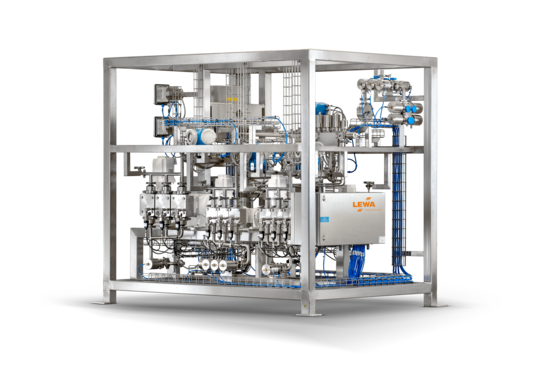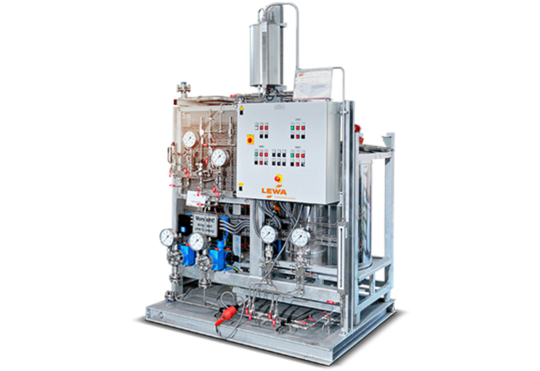Solutions
Metering systems for battery test facilities. Precise control, reproducible test results.
When traction batteries for electric vehicles are tested, extreme operating conditions are simulated. The test cycles vary in length from a few minutes to several hours. LEWA metering systems are used to dose a testing fluid in a closed loop to check the batteries at different temperatures in a wide temperature range.
These LEWA metering systems are divided into different layers: The first consists of a base frame, a drip pan and a cooling water connection. The second includes a tempering unit, metering pumps, measuring instruments and process connections. The third consists of a control cabinet, operating unit, controls and interfaces. By those, the metering systems can be easily connected to customer-side distributed control systems (DCS).
The ratio of the testing fluid is always unchanged, e.g. a water glycol mixture is used. The mixture is adjusted to the desired operating temperature by the tempering unit and then circulated in a closed loop through the batteries. With LEWA metering systems for battery test stands, fluids can be conveyed at temperatures of -30 to 85 °C, at flow rates of 30 to 900 l/h and at a maximum pressure of 10 bar. Metering systems for higher flow rates, temperatures or pressures are available on request.
The actual system components are furnished with thermal insulation. This is indispensable for the systems to prevent that ambient temperatures have an influence on the fluid temperature and its gradients. By this, reproducible results can be achieved. The process parameters volume flow and pressure are controlled symmetrically by the LEWA software in order to ensure reproducibility and stability. The software ensures that the maximum set pressure is never exceeded and does not damage the internal life of the batteries.

Background
Batteries in electric vehicles
In electric vehicles, so-called traction batteries are used. Lithium-ion batteries are the preferred type of traction batteries. In 2014, almost exclusively lithium-ion batteries were installed in electric vehicles.
The batteries are the central and at the same time the most expensive component of an electric vehicle and can add up to about 40% of the total costs. The traction batteries must be able to withstand a variety of charging cycles.
The so-called "memory effect", which is typical for many types of batteries, must not occur. The memory effect describes a loss of capacity of the batteries emerging over time and is characterized by an early voltage drop. As a minimum voltage is required, the battery runtime is sometimes significantly lower.
In the manufacturer's tests, the electric vehicle batteries are subjected to extreme operating conditions (such as high and low temperatures) in test cycles of varying duration. This simulates and examines the influences of the batteries’ aging process.
Industries
Pompe e impianti di misurazione per altri settori
LEWA progetta e costruisce soluzioni su specifica del cliente e rappresenta un punto di riferimento per la maggior parte dei settori che richiedono dosaggi precisi o il trasferimento affidabile di fluidi. In quanto specialisti nella manipolazione di fluidi, abbiamo ovviamente esperienza anche in settori al di fuori dei nostri mercati principali.
More DetailsProducts
Sistemi di dosaggio, miscelazione o riempimento LEWA secondo specifiche del cliente
Sistemi a lotti/continui secondo specifiche del cliente per il vostro processo di produzione. Dosaggio, miscelazione, riempimento, separazione, controllo della temperatura: Lavoriamo con voi per sviluppare la sequenza di processo ideale e per produrre il sistema che si adatti al vostro processo di produzione, fino al prodotto finale.
More DetailsSistemi di dosaggio LEWA secondo specifiche del cliente
Sistema di dosaggio chiavi in mano in circuito di regolazione chiuso con apparecchiatura di monitoraggio e di test della plausibilità. Sistema di dosaggio configurato individualmente con pompa progettata in modo ottimale per il dosaggio dei fluidi nei processi automatizzati.
More Details


